Chapter Nine—
The First Chamber Symphony, op. 9 (1906)
Judging from the disposition of materials in Sketchbooks II and III, Schoenberg began work on the First Chamber Symphony sometime between the end of 1905—after the spate of post-quartet song composition—and April 1906. The piece was completed by midsummer: the date at the end of the sketches and drafts for op. 9 in Sketchbook III is 17 July 1906; that at the end of the autograph score, 25 July. The First Chamber Symphony thus seems to have had a relatively swift and unproblematic genesis in comparison with the First Quartet, to which it is in many respects the direct heir.[1] The larger formal design of op. 7 is here condensed into a structure about half as long. The basic plan is shown in table 10. The streamlining results largely from the presence of a single development and from the drastic compression of the individual "movements." Unlike in op. 7, the finale introduces no new themes, but is purely recapitulatory.
Timings from two of the best recent recordings of the Chamber Symphony are included in table 10 to indicate not only how compact the work is in relation to op. 7, but also how well-balanced the various segments are from the viewpoint of duration.[2] The two outer movements, which are of approximately equal du-
[1] The publication history of op. 9, extending from 1912 to 1924, is slightly more complicated than its Entstehungsgeschichte. For full details, with a collation of the different printed sources, see SW B11/II: 14-28; see also Brinkmann 1977, 134-36.
[2] It should be noted that neither recording comes anywhere near the fast tempi suggested by Schoenberg's metronome markings for the first movement in 1922 edition of the Chamber Symphony. At the "sehr rasch" of m. 5, Schoenberg indicates that a half note should equal about 104. Reinbert de Leeuw, whose tempi seem very fast indeed here, takes the half note somewhere between 80 and 84. Although de Leeuw's tempi in the fast parts of the piece are noticeably quicker than Giuseppe Sinopoli's, his slow movement takes almost half a minute longer.
My own final tallies for timings in table 10 differ slightly from the totals given on the record liners; the difference can be accounted for by the fact that I have added the individual sections or movements individually, not always taking the same measure as the recording engineers of the silences or pauses in between.
| |||||||||||||||||||||||||||||||||||||||||||||
ration (4–5 minutes), are the lengthiest. As is suggested by the curved braces in the table, there is also greater balance, on either side of the central development and transition, between the first movement-transition-scherzo complex and the slow movement-transition-finale complex. (This balance is clearer in the timings of the recording by Sinopoli cited in table 10.)
Thematic and Formal Structure
The themes of op. 9 tend to be briefer, tauter, more compact than those of op. 7 (as has been observed by Brinkmann 1977, 138), but there are more of them. In the first movement, this profusion of material is accommodated within an ingenious design, which has not, to my knowledge, been previously clarified in print. Alban Berg (1921),[3] and most analysts following him (for example, Brink-
[3] Following the printed catalog of Berg's manuscripts prepared by Rosemary Hilmar (Grasberger and Stefan 1980, 99-100), I give the publication date of Berg's Thematische Analyse as 1921. The pamphlet itself bears no imprint date. It may in fact have appeared well before 1921, since Berg's contract for it, still in the archives of Universal Edition, bears the date 4 May 1918. (I am grateful to Sabine Franz of Universal for providing me with a copy of this document.) According to Willi Reich, the Analyse was completed and published in 1918 to coincide with a series of ten open rehearsals of the Chamber Symphony led by Schoenberg in June of that year (Reich 1965, 45). The one letter in the Berg-Schoenberg correspondence that mentions the analysis (Berg 1987, 268) gives no information about publication.
| ||||||||||||||||||||||||||||||||||||||||||||||||||||||
mann 1977, 144), have discerned a single exposition with a slow introductory portion (mm. 1-4), a large and multifarious first group (mm. 5-67), a transition (mm. 68-82), a lyrical second subject (mm. 82-113), and a fast closing group (mm. 113-32). But the first movement of op. 9 is best heard as comprising a double exposition, or pair of expositions (see table 11). We have seen in chapter 5 that such a design is proposed by Richard Swift for Verklärte Nacht (Swift 1977), but that this parsing is not supported by the thematic and harmonic disposition of the sextet. A much more persuasive case for this kind of plan can be made in op. 9. The principle of a double exposition is not, of course, without precedent. An obvious forebear is the classical-romantic first-movement concerto form. Richard Strauss's Don Juan, a piece Schoenberg surely knew well (it has the same tonic as op. 9, and its athletic thematic style may also have been influential) can also be heard as employing two expositions (a perspective discussed in Hepokoski 1992, 147). Although the conception of op. 9 may owe something to both models, Schoenberg's double exposition is sui generis; with it, he created a new formal synthesis of procedures with which he had been grappling imaginatively for over a decade.
The first exposition is preceded by two passages, which I shall call "cadences" because they serve to map out, or introduce emphatically, the two key areas, F
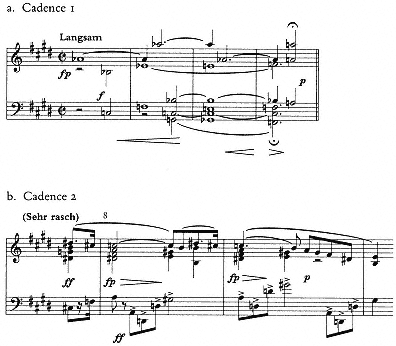
Example 9.1
First Chamber Symphony, op. 9.
and E, that are to dominate the succeeding expositions, especially the first (ex. 9.1).[4] Cadence 1 also behaves like a brief slow introduction. (I shall return below to the more specifically harmonic aspects of the expositions.) The two cadences also enclose the first statement of the horn "motto" of rising fourths that is to assume importance at larger formal articulation points in the piece. (In table 11 and in the discussion that follows, themes are distinguished by the exposition in which they originate; thus I/2 refers to theme 2 in exposition I. Since 1a is the same in both expositions, it will be referred to without a roman numeral.)
Each of the two expositions begins with the same theme (1a), which in both cases cadences on the tonic, E major. As has been suggested by Philip Friedheim (who, however, follows the tradition of perceiving a single exposition), this theme and subsequent ones tend to preserve the "thematic character" of the traditional sonata form, where "principal melodies remain strong and aggres-
[4] Berg 1921, 5, also refers to mm. 8-10 as the "cadencing theme," which, he suggests, appears throughout the piece when there is a strong cadence in E major.
sive, secondary melodies expansive and lyric" (Friedheim 1963, 337). Theme 1a is indeed aggressive; it is also somewhat asymmetrical and open-ended. It is succeeded by theme I/1b, which definitely has the character of a modulatory transition, especially by virtue of its prominent use of sequence (in overlapping four-measure units).
In both expositions, the "second" themes provide genuine contrast-in mood, in key, and in thematic material. The first of these (I/2, m. 32) differs from what has come before in extending a full (and regular) eight measures and in being accorded an actual counterstatement or repetition (beginning at m. 39), which, however, soon begins to deviate from the original. Similarly, the A-major theme (II/2) is an expansive one, lasting nine measures (clearly heard as an extension of eight by the varied repetition of m. 88 as m. 89). After a transitional addition of five measures, this theme too has a counterstatement, beginning (in the horn) at m. 97. Like the counterstatement of I/2, this one soon deviates from the original model.
After the cadences at the close of exposition II, cadence 2 and theme 1a make yet another return (mm. 133-36)-one that might suggest either another exposition or the beginning of a development section. In fact, however, the primary thematic material takes a different direction at m. 142 and leads toward the introduction of scherzo material at m. 148.
From the formal/thematic viewpoint, the scherzo of op. 9 is no less remarkable than the first movement. Schoenberg here moves away from the clear scherzo-trio-scherzo plan of op. 7, but retains the essential thematic dualism of that design. The two principal themes are closely related. The nervous accompanimental figure to theme 1 (ex. 9.2b) is modified to become theme 2 (ex. 9.2c). The principal voice of theme 1 can also be heard to derive from the prominent ascending semitones in the second violin at cadence 1 (ex. 9.2a).
The way in which the two themes are introduced and developed gives the scherzo a shape closer to sonata form than to the tripartite scherzo plan:
Theme 1 [scherzo], m. 160
transition, m. 184
Theme 2 [trio], m. 200
Development, m. 215
Recapitulation [scherzo], m. 249
The passage in mm. 215-18, with the final appearance (for the moment) of theme 2, followed by the sustained horn pedal, clearly indicates the end of an important
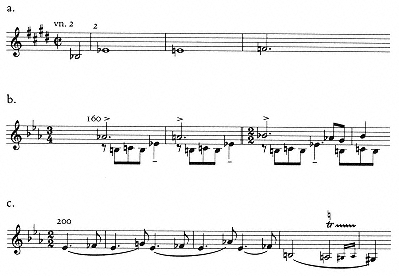
Example 9.2
First Chamber Symphony, op. 9, derivation of scherzo themes.
segment. It is followed by the reappearance of a portion of theme 1, precisely in the way we might expect at the beginning of a development section. The "recapitulation" is remarkable for its extreme compression, which in a sense fulfills the latent identity between themes 1 and 2: they are now recapitulated simultaneously in mm. 253-58
The reader will recall that in op. 7 the reprise of the scherzo leads directly into a large development section, in which scherzo material gradually gives way to that from the first movement. Schoenberg's strategy in op. 9 is somewhat different. The end of the scherzo is clearly demarcated by the sustained fortissimo Es of mm. 274-79, and by the reappearance of the horn motto, now descending in fourths (mm. 279-80). The development section begins with a distinct contrast of key, tempo, and thematic material. The initial motive of theme I/2 reappears in its original key, F minor. It is followed-interrupted, one might almost say- by cadence 1, then by theme II/2, which dominates the first part of the development.
Berg rightly observes that the development section of the Chamber Symphony divides into three segments: part I, mm. 280-312; part II, mm. 312-35; and part III, mm. 335-67 (Berg 1921, 9-11). The segments are distinguished primarily by means of thematic material, which is arranged in order of progressively greater
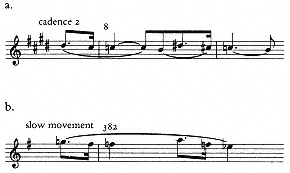
Example 9.3
First Chamber Symphony, op. 9, derivation of slow movement theme.
rhythmic activity, so that a listener might perceive an increase in tempo, although there is none. Throughout this process, Schoenberg preserves the essential character of the themes as they were introduced in the expositions and the scherzo. Thus part I of the development begins with the slower "second" themes from the first movement expositions and is dominated especially by II/2, whose lyricism makes an appropriate contrast with the headlong pace of the scherzo. At the beginning of part II, the tempo quickens to the Anfangszeitmaß, the "sehr rasch" of the opening of the piece. It remains essentially at this tempo for the rest of the development; the impression of increasing speed is created by Schoenberg's choice of themes.
Part II is governed by theme II/1b, which in its original appearance (m. 68) preceded II/2 and formed a kind of transition from the assertive II/1a. Here it has the opposite function, representing an increase in rhythmic activity from II/2. Part III begins with part of theme 1 of the scherzo, which represents a still greater increase of rhythmic activity. The scherzo theme is combined with II/1b; gradually the other "fast" theme, 1a, emerges (beginning at m. 341).
The development culminates with the triple forte chords in fourths of mm. 363-68. This sonority represents a compression into a simultaneity of the horn motto powerfully presented in mm. 358-62. (I return to the significance of this moment below.) This passage at 363-68, standing essentially at the midpoint of the work, is the formal analogue of the massive liquidation of the first theme before K in the D-Minor Quartet. In the quartet, the liquidation was followed directly by the slow movement; in the Chamber Symphony, this moment is followed by a kind of regeneration of the motto and of cadence 1 in mm. 368-77.
The main theme of the slow movement derives audibly from the twofold dot-
ted figure of cadence 2 (ex. 9.3a, b). The relationship is especially appropriate here since the theme comes after the horn motto and cadence 1 and thus occupies a formal position analogous to that originally occupied by cadence 2 (in mm. 8-10). By making this analogy to the opening of the piece, Schoenberg signals the beginning of a large new segment of the Chamber Symphony.
The slow movement proper has a lucid design, in which material of great variety is fitted into a compact structure:
Introduction/cadence (mm. 378–81)
Main theme (mm. 382–85)
Contrasting theme (mm. 385–90)
Main theme repeated and varied (mm. 391–94)
Contrasting theme repeated and varied (mm. 395–97)
Introduction/cadence repeated and extended (mm. 398–404)
Main theme (mm. 405–7)
Coda (mm. 407–10)
One distinctive aspect of this design is the reappearance of the introduction/cadence at m. 398 to form the real climax of the section.
The slow movement is followed by the return of the fourths motto and by cadence 1; this leads into a lengthy passage, mm. 415–34, that in the overall analysis of op. 9 (table 10) has been called episode/transition. This segment seems to have two functions. First, it is a continuation and thematic variation of the slow movement. The last segment of the theme of this section, consisting of two descending semitones and rising major third (diminished fourth), is derived clearly from the slow movement theme, a derivation made more obvious in the horn melody that emerges at m. 430 (ex. 9.4a, b). Second, the segment of mm. 415–34, which has a B-major key signature, appears intended to function as a transition to the recapitulation, which may be said actually to begin with the E-major key signature at m. 435. Despite its apparent functions, however, the passage from mm. 415–34 is one of the most puzzling in the Chamber Symphony, as will be discussed below in conjunction with the recapitulation.
The recapitulation/finale of the Chamber Symphony posed the kind of challenge Schoenberg had faced several times before in his large-scale instrumental compositions. In op. 9 the solution proves as ingenious as the exposition. Schoenberg creates a double recapitulation that is analogous but in no way identical to the double exposition in terms of harmonic areas and thematic disposition (see table 12). The thematic components of the two expositions are now intermingled
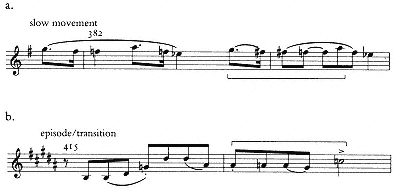
Example 9.4
First Chamber Symphony, op. 9, relation of slow movement theme to episode/transition.
in a logical yet flexible way. The double recapitulation is followed by a two-part coda.
The analysis suggested in table 12 differs not only in detail but overall from that of Berg, who places the start of the recapitulation at m. 410, with the horn call, and the "coda" at m. 497, at the beginning of what I have called recapitulation II. Berg calls my coda II an Endkoda. Berg's coda seems unusually and disproportionately long and does not take sufficient account of the treatment of the slow movement theme, which is actually taken up at greater length than its original presentation. In the slow movement proper, the theme unfolds for only twenty-seven measures before giving way (at m. 410) to a new transitional theme in B major. The fuller treatment of the theme at mm. 508–41 would seem more appropriately considered part of a recapitulation than a coda. Placing the beginning of the coda at m. 555, as I have suggested, creates an analogy with the codetta in exposition II: in both, a transformed, fast version of II/2 leads into cadence 3 (ex. 9. 5a, b).
Wherever one chooses to place the traditional formal boundaries, it is important to remember that these are only labels of convenience that fix—and thus to some extent falsify—what is in the Chamber Symphony an extremely fluid process. This fluidity makes it particularly difficult to pinpoint the actual beginning of the recapitulation. Schoenberg's principal compositional goal is to prepare the return of the tonic, E major. The portion of the slow movement that comes after the horn motto and fourth chords of mm. 410-14 is given a B-major key signature. The tonic key signature returns at m. 435, with the appearance of theme II/1b, which, however, really continues in the previous B major. The tonic itself begins
| |||||||||||||||||||||||||||||||||||||||||||||||||||||||||||||||||||||
to emerge only at m. 448 with theme II/2, then more definitively with the simultaneous presentation of 1a and cadence 2 at m. 476. Following convention, I give the moment at which the key signature changes as the beginning of the recapitulation, but one might with equal justification point to the fortissimo statement of the horn motto at m. 473.
Dominant Relationships
The matter of recapitulation-and, indeed, of formal structure in general-is intimately bound up with the harmonic dimension of op. 9, especially with the structural role of the dominant. The principal rationale for arguing for a double

Example 9.5
First Chamber Symphony, op. 9, relation between codetta (a) and final coda (b).
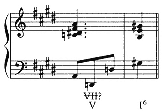
Example 9.6
Schoenberg's analysis in Structural Functions of Harmony of cadence 2 in First Chamber Symphony, op. 9.
recapitulation is that as in the exposition there is a double approach to the tonic: first at m. 448, then again more explicitly at m. 497. This procedure is roughly, but surely intentionally, parallel to the double approaches at mm. 8-10 (with cadence 2) and mm. 56-58. What is significantly different from the exposition is the role played by the dominant, B major, in these later passages and in coda II at mm. 573-76.
In the expositions, Schoenberg tends to avoid any sustained or explicit dominant of E major. Thus in cadence 2, as the composer himself demonstrated in Structural Functions, there is no B in the bass of the dominant chord; it must be inferred through "multiple root reference of a diminished 7th chord" (Schoenberg 1969, 110-11; see my ex. 9.6). (In fact, a B root is heard fleetingly in the horns on the last beat of m. 8.) But at the recapitulation, as in the recapitulatory portions of opp. 4, 5, and 7, Schoenberg clearly felt the need for a stronger V-I

Example 9.7
First Chamber Symphony, op. 9, cadences to E from the dominant.
resolution. The most forceful such cadences, with a clear B in the bass, come at mm. 493-97 and at 572-76 (ex. 9.7a and b).
During the compositional process of the Chamber Symphony, as in that of Verklärte Nacht and the First Quartet, Schoenberg was clearly concerned with, and somewhat uncertain about, how much dominant preparation would be necessary or appropriate toward the end of the work. The one major compositional change indicated-but then revoked-in the autograph score of op. 9 was made, I believe, precisely because of this concern. In the autograph (at the Pierpont Morgan Library), all of mm. 415-34, the passage with the B-major key signature that has been referred to above as an episode/transition, is indicated for deletion with a red pencil; Schoenberg used a "VI-DE" to cut directly from m. 414 to the present m. 435-that is, from just after the horn motto and cadence 1 to the recapitulation of theme II/1b in B major. Then he changed his mind and wrote
"bleibt" above the passage, thus restoring it in full. It is not clear exactly when he would have made these markings, but it was certainly after the autograph was written out.[5]
Schoenberg's vacillation about the episode/transition is suggestive. As a listener to the Chamber Symphony and student of the score-well before I had ever consulted the autograph-I had found the passage at mm. 415–34 oddly stagnant for so relentlessly logical a composition. Are we to take it as a resumption of the slow movement after the interpolation of the horn motto and cadence 1? As such, it would break the precedent of using the motto as a marker of important formal junctions in the large-scale form. Or is it a transitional episode meant to lead into the recapitulation? In this latter role, it seems unusually, uncomfortably long for this work, where transitions tend to be relatively brief and focused.
That Schoenberg considered cutting mm. 415–34 can be taken as an indication that he too was somewhat puzzled about the function of the episode/transition. As he realized, the horn motto and cadence of mm. 411–14 could lead quite smoothly and logically, as indicated by the provisional cut, to the reprise of theme II/1b in m. 435. And Schoenberg may have felt that since the slow movement theme already receives such an extensive recapitulation—expansion, really—at mm. 508-41, an extensive episode derived from the slow movement theme at mm. 414-34 would come to seem redundant.
In the end, however, Schoenberg's instincts told him to leave the passage intact. He did so, I believe, not because of its contribution to the development of the slow movement theme, but because of its harmonic implications: these measures provide necessary time spent in or about the dominant. The appearance of II/1b in the dominant at m. 435 (it is heard in B despite the change of key signature to E) would not alone be sufficient; the passage at mm. 414–35 gives additional weight to the dominant. Even so, very little of the episode/transition actually sustains a dominant of E, since harmonic stability is constantly threatened by the pervasive chromatic counterpoint. One suspects that the key signature of B retains an almost purely symbolic value for Schoenberg. Somewhat like the A major of the rondo theme of op. 7 examined in chapter 8, it represents the dominant that Schoenberg was finding increasingly harder to sustain as a functional element in his music.
Whole-Tone and Quartal Elements
The role of dominants in op. 9 is intimately bound up with Schoenberg's extensive use of whole-tone and quartal elements. At the opening of the work,
[5] Similar cuts are indicated in the autograph score of Schoenberg's own four-hand arrangement of op. 9 (at the Schoenberg Institute). For a description of both cuts, see SW B11/II: 13; and B5: 85.

Example 9.8
First Chamber Symphony, op. 9, whole-tone chord as dominant seventh of F.
Schoenberg explicitly-almost didactically-demonstrates how whole tones and fourths can (and will) penetrate both the vertical and horizontal dimensions of the music. First, with cadence 1, comes an essentially chordal or vertical presentation, a fourths-whole-tone-triad progression resolving to F major. The horn motto then horizontalizes the fourths, and the transition to cadence 2 does the same for whole tones by successively unfolding the augmented triads


I have already reviewed Schoenberg's own theoretical derivations of the whole-tone complex and demonstrated something of its realization in op. 7 (chapter 8). We recall that in both theory and practice Schoenberg treats whole-tone scales or chords not as purely symmetrical, rootless phenomena, but as harmonically functional ones; he often derives whole-tone structures from, or relates them to, conventional dominants. In this respect, as in so many others, the First Chamber Symphony is a worthy successor to the First Quartet, making good on the inheritance. The second chordal component of cadence 1 contains five notes of the whole-tone scale (ex. 9.8). If inverted so as to put the C in the bass, the chord can be heard to function as a dominant of F major, with the fifth simultaneously raised and lowered, in the way suggested by Schoenberg in Theory of Harmony (1978, 392) and discussed above in connection with the D-Minor Quartet. (See the similar analyses of the opening of op. 9 in Morgan 1991, 66, Rexroth 1971, 356-59, and Brinkmann 1969, 6-8.) The dominant function might be said to be reinforced by the doubling of the leading tone,

This aspect of the whole-tone complex becomes still more explicit at the cadence to theme I/2 in F minor at mm. 30–32 (ex. 9.9). In m. 30, all six notes of the whole-tone scale are present; although not sounded as a chord, they are clearly oriented around or toward the C root. In the next measure, the C fully

Example 9.9
First Chamber Symphony, op. 9, cadence to theme I/2.
establishes itself as a dominant, and the whole-tone scale gives way to a more conventional half-step approach to F in the violins.
Schoenberg's theoretical and compositional treatment of chords built of fourths is similar to his approach to the whole-tone complex. In Theory of Harmony, he observes that fourth (quartal) chords "are chords like all others" (1978, 404) and can be produced by-and thus can function as-alterations within the triadic system (see also Rexroth 1971, 318–25). He also stresses their possible dominant function: both four-part and five-part quartal harmonies "can be substitutes for a dominant, from which they are derived by lowering the root (if one wishes to admit such), the seventh, and the fifth for the four-part quartal chord" (Schoenberg 1978, 405). It is striking that Schoenberg should suggest-even if diffidently and parenthetically-the lowering of the root, the one chord component that he elsewhere claims not to be subject to alteration: "The roots are, in our conception, fixed points from which relationships are measured. The unity of all the measurements we have found is guaranteed by the immobility of these points. But then one may not move them!!" (Schoenberg 1978, 234). Schoenberg's willingness to condone the possibility of root alteration in quartal harmonies shows how strong is his impulse to relate even the most exotic constructions to diatonic roots.
The resolutions of the quartal harmonies demonstrated in Theory of Harmony are especially relevant to an understanding of compositional practice in the Chamber Symphony. Schoenberg observes that in a six-part quartal chord, the top voice forms a minor ninth with the bass. Because this ninth represents "the first 'rather sharp' dissonance among the fourth chords," he suggests that the resolution of the ninth be a priority (Schoenberg 1978, 405–6). One of his solutions in Theory of Harmony, as reproduced in ex. 9. 10a, is quite close to cadence 1 in op. 9 10b, which is a reduction of ex. 9. 1a). Both begin with a six-
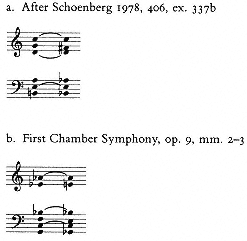
Example 9.10
Resolution of six-part fourth chord.
part quartal chord; in both, three notes, including the ninth above the bass, are held over into the next chord, which is in both cases a whole-tone sonority.
In the Theory of Harmony example, Schoenberg claims to demonstrate "a connection that also appears in my Kammersymphonie " (406). In fact, however, the six-note quartal harmony in mm. 2-3 of op. 9 does not resolve precisely as indicated in Schoenberg's textbook example, because as can be seen in ex. 9. 10b, the whole-tone chord of resolution in cadence 1 has five, not six, pitch classes. Instead of moving down by half-step, as in the model (ex. 9. 10a), the second voice from the top resolves up, from




In all, cadence 1 appears five different times in the Chamber Symphony: once at the opening, twice in succession just before the slow movement at mm. 374–77, and twice again at the end of the slow movement, mm. 411–14. In none of these places does the pattern correspond to Schoenberg's model in Theory of Harmony. In the passages at mm. 374–77 and 411–15, the cadence first behaves as at the opening, leading to F major (ex. 9.11a and d), and is then refashioned to lead toward the key of the succeeding passage. The reworking at mm. 376–77 (ex. 911b) corresponds to a different model proposed in Theory of Harmony (ex. 9.11c; Schoenberg 1978, ex. 336, m. 3), where the six-part quartal chord leads to
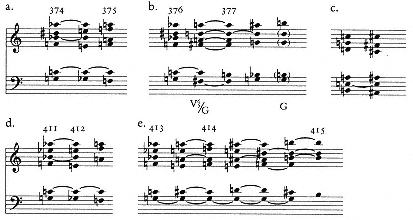
Example 9.11
First Chamber Symphony, op. 9, appearances of cadence 1 (a, b, d, e); resolution of six-part fourth chord after Schoenberg 1978, 406, ex. 337, m. 3 (c).
a first-inversion dominant seventh. In op. 9, the dominant seventh is V of G, the key of the slow movement. It could be said that this passage makes explicit or overt the dominant function that was implied in the original form of cadence 1, which has just been heard once again before the reworking. At the final occurrences of cadence 1, in mm. 411–15, Schoenberg repeats the original form once again (ex. 9.11d), then modifies it still further to resolve eventually to the dominant of E major (minus the fifth; ex. 9.11e).
Neapolitan Relationships
In Theory of Harmony, Schoenberg notes that quartal sonorities "place their stamp on everything that happens" in the Chamber Symphony (Schoenberg 1978, 404). While it is true that both cadence 1 and the horn motto blaze a trail through the work, they constitute only one aspect of its richly complex tonal world. Indeed, one harmonic relationship that seems to lie at the core of much of op. 9 derives directly from neither whole tones nor fourths (although an affinity to the latter will be suggested): it is generated by the half-step E-F. The Chamber Symphony, especially its first movement and finale, constitutes Schoenberg's most profound exploration to date of the relationship between a tonic and its Neapolitan upper neighbor.
The key areas of F major and E major are emphatically juxtaposed at the very opening, where cadence 1 is in the former, cadence 2 in the latter (see above, ex. 9.1). This juxtaposition, so portentous for the work as whole, was apparently not
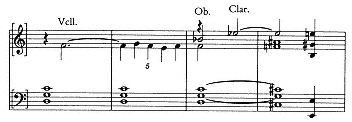
Example 9.12
First Chamber Symphony, op. 9, sketch for cadence 1, in Sketchbook II, p. 92.
part of Schoenberg's earliest notated conception. In the first surviving sketch for cadence 1 (ex. 9.12; see also SW B11/II: 42 [S3]) the opening chord is built from a different set of fourths,

Cadence 2 is more conventional than cadence 1 and is accompanied by (or accompanies) a dynamic melodic gesture. This can be taken as a sign that E major, and not the F major of the introduction, is the real tonal center of the work. Another sign is the prominent motivic gesture within cadence 2,



The cello theme, 1a, also embodies within itself the crucial F-E harmonicthematic relationship. In m. 12, the theme swerves sharply from its E-major orbit with the ascending figure,


It is instructive to consider the pervasiveness and the boldness with which Schoenberg exploits the Neapolitan in op. 9 (and there is more to say about this below) in light of his own theoretical statements. Like other nineteenth-century
theorists, Schoenberg sees the tonic and its Neapolitan as related through the mediation of the subdominant minor (A minor in the case of op. 9), in which region the Neapolitan triad forms a diatonic chord (VI, F major). But Schoenberg also decides that "in spite of the mediation of the minor subdominant relation: these two chords [a tonic and its Neapolitan] are about as remotely related as chords can be. And if we connect them so directly we are right on that boundary where we can say: all chords can be connected with one another" (Schoenberg 1978, 235). Even in Schoenberg's more systematic treatment of harmonic relationships in Structural Functions of Harmony, the Neapolitan is still a remote, slippery phenomenon; in the schematic chart of the regions, in which keys are visually arranged around a central axis according to nearness or remoteness to the tonic, the Np hovers ambiguously outside the main grid (Schoenberg 1969, 20).
Despite the remoteness of the Neapolitan in theory, this scale degree is explored in practice in Schoenberg's earlier tonal works with great imagination. We have already examined some of these procedures in Verklärte Nacht (chapter 5) and Gurrelieder (chapter 6). More direct precedents for op. 9 are to be found in three works in which this tonal relationship occurs at the same pitch level, that is, E-F. Two of these are the songs Traumleben, op. 6, no. 1, and Natur, op. 8, no. 1, which were drafted on the same day, 18 December 1903. (Natur was completed and orchestrated in March 1904.) In both songs, the tonic E major is frequently enriched by, and inflected toward, the Neapolitan F. In Traumleben, the opening melodic phrase contains all the notes of the F-major triad, spelled enharmonically as A,


A still more direct way of shuttling between the key areas of F and E—and one highly relevant to Schoenberg's method in op. 9—appears in the slow movement of the D-Minor Quartet, op. 7. Although this movement, which has an ABA' form, begins in A minor, the principal key area of the A section is F minor/major. Toward the end of this section (one measure before K 45 in ex. 9.13), Schoenberg confirms F major with its own dominant. At the cadence in K 45, Schoenberg introduces in the second violin (imitated in the cello) a phrase from the second group of the first movement. In its final statement, in the viola in
[7] For further discussion of Traumleben and these particular Neapolitan relationships, see Cone 1974, 30–32; Wintle 1980, 57–64; and Lewis 1987, 32–37.
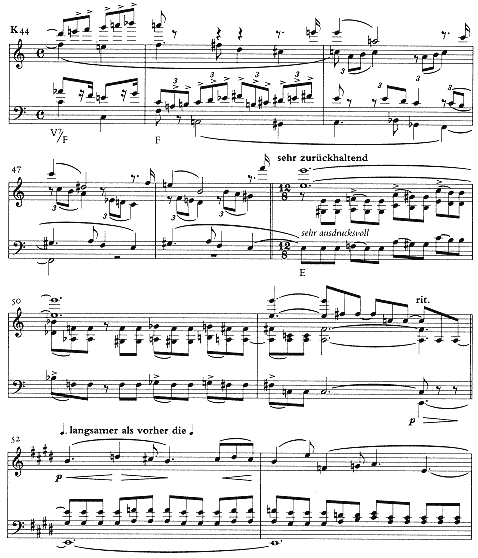
Example 9.13
First String Quartet in D Minor, op. 7, slow movement.
K 47-48, this phrase emphasizes the neighbor-note motives


On the final beat of K 48 (just before the double bar and change of meter), the lower voices sustain the dyad








In an abstract theoretical sense, the relationship between E major and F minor, between a tonic and its Neapolitan minor, is still more remote than the conventional one, since it involves a further transformation or substitution, that of F minor for F major. This particular relationship is so remote that Schoenberg addresses it specifically nowhere in either Theory of Harmony or Structural Functions.[8] And yet in the tonal world of the First Chamber Symphony, F minor is really closer to the tonic than is F major. The key area of theme I/2 represents an attempt to reconcile or bring together the two key areas, F and E, which have been juxtaposed in the first theme group. The F-minor triad shares one note,


Schoenberg himself may well have been thinking along these lines when composing op. 9. Such at least is one possible interpretation of some of the fascinating sketches for the F-minor theme, I/2. The position of these sketches within

Example 9.14
Connection of E major to F minor through stepwise voice-leading.
the sketchbook suggests that this theme may originally have been intended as the main theme (a hypothesis advanced by Schmidt in SW B11/II: 43). These sketches directly follow those for the opening cadence 1 and precede those for the theme that eventually became 1a. Schoenberg himself transcribes five of the twelve sketches for the F-minor theme in his essay "Heart and Brain in Music" (Schoenberg 1975, 59-60).[9] He makes no comment on the harmonic, or enharmonic, implications of the theme's evolution; his goal is only to give an idea of how much labor and revision was involved in forging the theme. But nothing speaks more tellingly of the relationship Schoenberg attempts to establish between E and F than the successive drafts of I/2, in which the theme, always at the same pitch level, is first cast in the key of E major, then gradually shifted toward F minor.
It is not necessary here to trace the entire evolution of the theme across the surviving sketches (the reader can consult the transcriptions and commentary in SW B11/II: 45-49 [S8-9, 11-20, 33, 39, 40]); but some idea of this process can be given. In the first surviving sketch (S8, excerpted in my ex. 9.15a), the theme appears underneath a sustained dyad





The new harmonic context of F minor is made explicit in S16 (ex. 9.15c), where, in the upper staff, Schoenberg moves by semitone voice-leading from E major to F minor (and then beyond, to A major) in exactly the fashion suggested above in my ex. 9.14: the fifth of the E triad is raised to C, which is then interpreted as a dominant of F minor, so that the E resolves up by half-step to F. The sequence by which F minor is reached is now repeated, so that we end up at

[9] Schoenberg's examples correspond to those transcribed in SW B11/II: 46-48, as follows: Schoenberg's ex. E=S11 ex. F=S12; ex. G=S13; ex. H=S16; ex. I=S17.
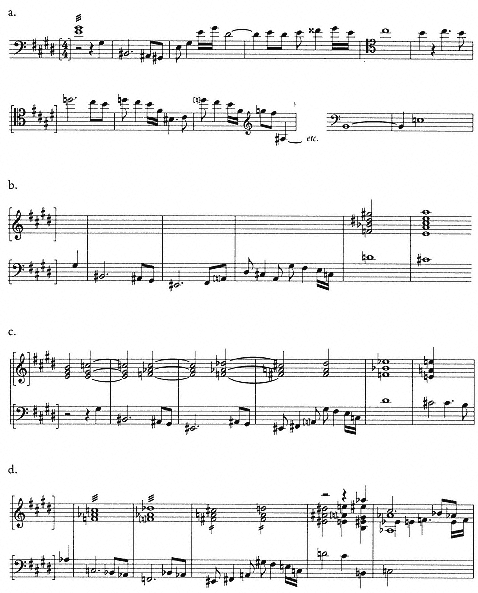
Example 9.15
First Chamber Symphony, op. 9, sketches for theme I/2, in Sketchbook II, pp. 92–94, 102.

Example 9.16
First Chamber Symphony, op. 9, Schoenberg's derivation of theme I/2 from 1a (from Schoenberg 1975, 85).
triad or of the following augmented triad; the progression now begins in F minor. The earlier sketches thus spell out explicitly (almost as if in a theory book) the voice-leading relationship between E major and F minor, a relationship that can only be inferred in the final version.
In one of his best-known musical analyses, presented in two different essays, "My Evolution" and "Composition with Twelve Tones," Schoenberg showed how his "subconscious" (as dictated by the "Supreme Commander") had created a deep structural relationship between the two apparently contrasting principal themes (my 1a and I/2) in the first group of the Chamber Symphony (Schoenberg 1975, 85, 222-23). He isolates certain pitches of 1a and demonstrates how by inversion they form the notes of I/2 (ex. 9.16). The derivation may seem a little farfetched, calling to mind the more fanciful thematic analyses of Rudolf Réti (Réti 1951), but from the viewpoint of the E-F relationship investigated here, Schoenberg's analysis is suggestive indeed; it establishes an identity between the


To continue with the Neapolitan story of the Chamber Symphony: the relationships between E and F set out in exposition I come into play again at the end

Example 9.17
First Chamber Symphony, op. 9, climax of F–E juxtaposition.
of the development section, at mm. 355-68, where the two pitches are forcefully juxtaposed in one of the most compelling passages of the work (ex. 9.17). Here the fourths motto reappears, triple forte, in a form that at first descends and ascends between the outer extremes of




This remarkable passage, which Adorno (citing an anonymous conductor) aptly characterizes as resembling a "glacier landscape" (Adorno 1981, 158), lies virtually at the midpoint of the Chamber Symphony and can be said to represent its most powerful and dissonant climax. Here the F and E have been brought together in (or around) a six-note quartal harmony of the type that, as discussed above, Schoenberg characterized as "rather sharp," with the minor ninth between the outer parts. It is here, at the climax, that we are made aware of the relationship between fourths and Neapolitan half-steps, phenomena that have up to this point been manipulated more or less separately. Both are embodied in the chord of m. 364, with F at the top and E at the bottom.
The F-E relationship is fully resolved only near the very end of the Chamber Symphony, at mm. 582-84 (ex. 9.18). Here a sustained F-major triad moves, via an intervening whole-tone run, to E major for the last time. This cadence follows, and is meant to be heard in apposition to, the more conventional dominant cadence of mm. 573-76 (see above, ex. 9.7b). Indeed, it seems to replace or su-
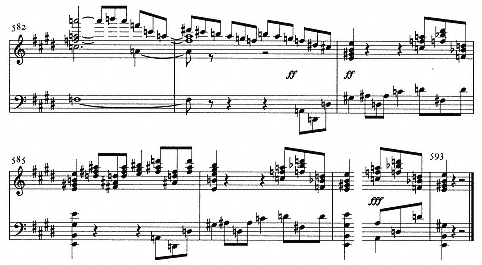
Example 9.18
First Chamber Symphony, op. 9, resolution of F–E relationship.
persede that earlier cadence, as if Schoenberg is saying that in the Chamber Symphony, Neapolitan relationships have greater force than dominant ones. In these final pages, which seem to tie together all the harmonic and thematic threads of the work, the F-E nexus is further enriched by the strong presence of C major, which is both the dominant of F and Neapolitan to B. It is in the latter role that C functions principally here, although at first it moves directly to E major without any intermediate resolution to the dominant.
At m. 562, cadence 3 appears for the first time since the first movement. It is reiterated forcefully over the next nine measures. The first two times it resolves to C (ex. 9.19a); then it moves twice to E major (ex. 9.19b). On the downbeat of m. 567 the cadence resolves again to C; this resolution is now prolonged or expanded over four measures as the bass descends through the complete wholetone scale from C to C. In mm. 572-73, the C at last resolves downward to


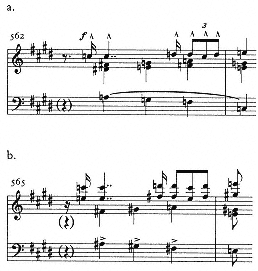
Example 9.19
First Chamber Symphony, op. 9, final appearances of cadence 3.
in the bass derives not from a traditional A major but from the Neapolitan realm of F (and its related keys, C and

More than any other instrumental work of Schoenberg's early period, the Chamber Symphony is characterized virtually throughout by an urgent, occasionally frantic, quality. One has the feeling that (to adopt an Adornian mode of expression) the musical material itself is pressing up against its own technical and expressive limits. With its fifteen individual voices competing for attention, the Chamber Symphony represents, as Reinhold Brinkmann has suggested, an extreme of polyphonic subjectivity (Brinkmann 1977, 148). Schoenberg's suggested metronome markings (virtually impossible to execute) make the faster themes of op. 9 seem especially breathless. The themes of op. 9 also generally have an expansive range, both tonally and registrally. Cadences or cadential figures are often repeated, as if insisting on closure in the face of skeptical disbelief. Indeed, as I have suggested, the piece begins with two cadences that take on important structural and thematic functions. In this way Schoenberg seems to be
exploring the possibility, or the adequacy, of closure in a complex, tonally advanced composition.
Schoenberg considered op. 9 to represent the "climax" of his "first" (or tonal) period:
Here is established a very intimate reciprocation between melody and harmony, in that both connect remote relations of the tonality into a perfect unity, draw logical consequences from the problems they attempt to solve, and simultaneously make great progress in the direction of the emancipation of the dissonance. This progress is brought about here by the postponement of the resolution of "passing" dissonances to a remote point where, finally, the preceding harshness becomes justified.
SCHOENBERG 1975, 84
Our investigation of the E-F relationship in the sketches and the finished work has, I hope, revealed a profound example precisely of Schoenberg's ability to bring "remote relations" into a "perfect unity" in a logical fashion. We have not looked closely here at the opposite tendency mentioned by Schoenberg, at the incipient emancipation of dissonance. The emphasis has been primarily on forces of resolution and coherence, for I believe that the First Chamber Symphony is ultimately a work that confirms or affirms the power of tonality to articulate large-scale form. Within the frantic voice of op. 9, there is also a tone of joy, a sense of exuberance ("stormy jubilation," as Schoenberg described the horn motto in his Theory of Harmony [1978, 403]). The First Chamber Symphony is the last big composition of Schoenberg's early period to embody this attitude. As we shall see in the next chapter, the Second Chamber Symphony and Second Quartet take a more somber, sober approach to the problems of tonal composition.



